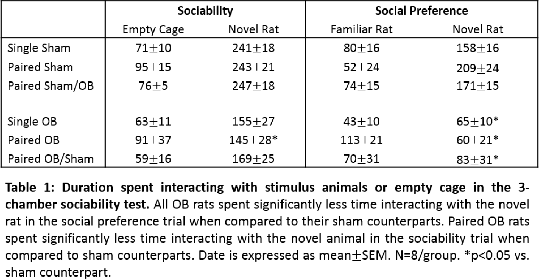| 164P London, UK Pharmacology 2017 |
An assessment of single versus paired-housing on social cognition in the 3-chamber sociability test in the olfactory bulbectomized (OB) rat model of depression
Introduction: Psychiatric disorders such as depression are associated with a number of social cognitive deficits. The olfactory bulbectomized (OB) rat is a well-characterised model of depression that we have recently begun to explore for social cognitive deficits. OB-related alterations have been found when animals have been singly housed (to facilitate home cage tracking). This study was conducted to see whether such cognitive alterations were apparent when an OB rat was pair-housed with another OB or a sham-operated cage-mate.
Methods: Male Sprague Dawley rats (200-250g) underwent surgery (sham or OB) using isoflurane anaesthesia, and either singly housed or housed as paired sham rats, paired OB rats, or a sham paired with an OB rat (n=8/group). Four weeks post-surgery, rats were placed in the 3-chamber sociability test, a test consisting of three consecutive ten-minute time-trials; the habituation trial (exploration of an empty arena), the sociability trial (exploration of a novel rat vs. an empty cage) and the social preference trial (exploration of a now familiar rat vs. a novel rat). Total distance moved was measured using Ethovision® video-tracking technology, with the degree of habituation to the arena being calculated as the 3rd trial as a percentage of the 1st trial. Duration interacting was manually scored. Data are expressed as mean ± SEM and analysed using two-way ANOVA, followed where appropriate by post-hoc Student Newman-Keuls test; p<0.05 was deemed statistically significant.
Results: In the sociability trial, only OB rats that were paired together spent significantly less time interacting with the novel animal than their sham counterparts. In the social preference trial, regardless of housing, all OB rats spent significantly less time interacting with the novel animal than their appropriate sham counterparts. All OB groups displayed a significant habituation when compared to sham counterparts.
Conclusion: Olfactory bulbectomy causes an altered social cognitive profile consisting of a reduction in social preference and a characteristic habituation to the test arena which is evident in all housing conditions. Pair-housing preserves the phenomenon that is seen in single-housed OB rats and has no discernible impact on the OB model. Future studies could adapt to employing pair-housing an OB rat with a sham, to negate the necessity for single-housing. These results demonstrate that pair-housing can be employed in the 3-chamber paradigm without affecting the characteristic OB-induced behavioural profile.
Acknowledgement: Strategic Partnership Programme Grant from Science Foundation Ireland and Alkermes, Inc. (14/SPP/B3051).


